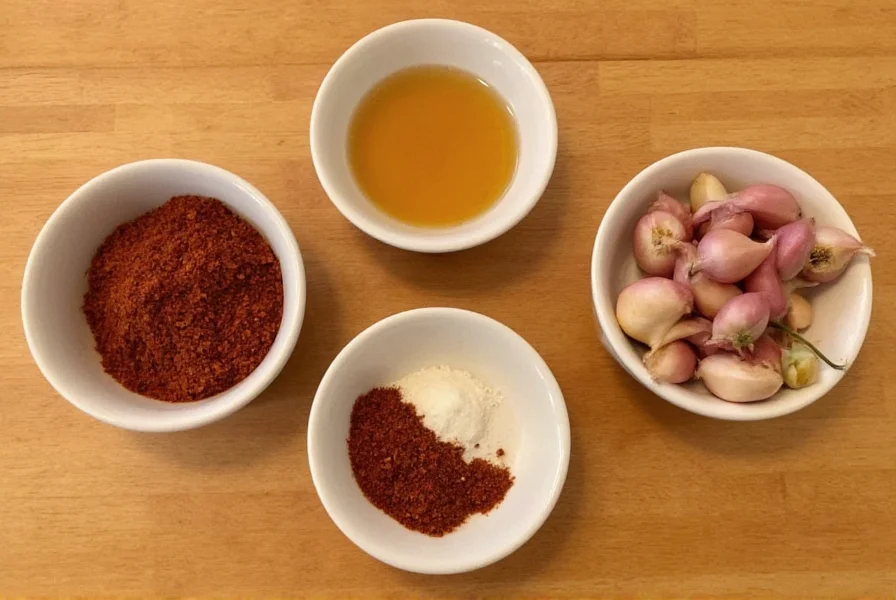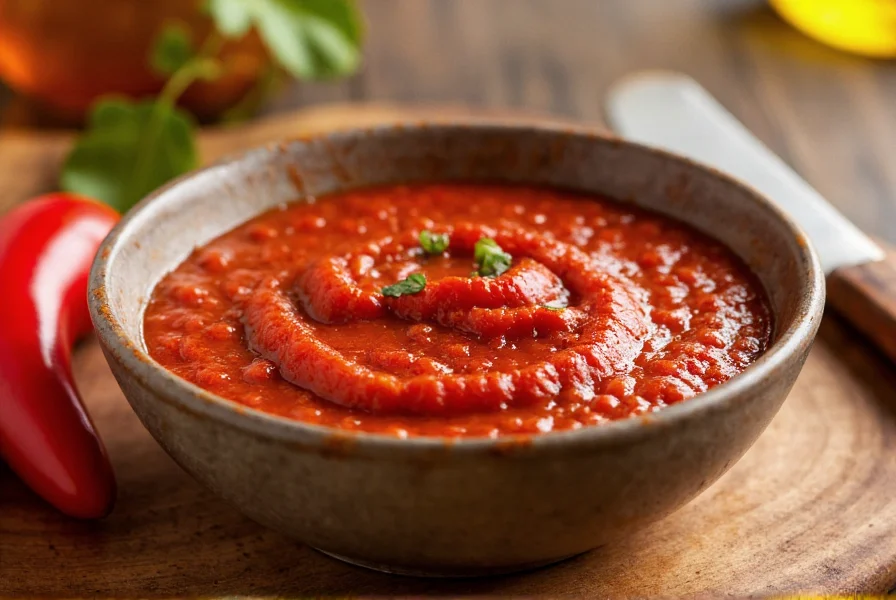When your recipe calls for chili paste but you're staring at an empty pantry shelf, knowing the right substitute can save your cooking project. Chili paste comes in many varieties across global cuisines, each with distinct flavor profiles and heat levels. Understanding these differences is crucial for selecting an appropriate replacement that maintains your dish's intended character.
Understanding Common Chili Paste Varieties
Before selecting a substitute, recognize that "chili paste" refers to multiple condiments with unique properties. The most common types include:
- Sambal oelek - Indonesian paste made from ground chilies, vinegar, and salt with minimal additional ingredients
- Gochujang - Korean fermented paste featuring chili powder, glutinous rice, and sweeteners
- Sriracha - Thai-inspired sauce with vinegar, garlic, and sugar creating a thinner consistency
- Chili garlic paste - Similar to sambal but with prominent garlic flavor
Each variety brings different flavor dimensions to recipes, so your substitution choice should align with the specific culinary tradition you're working within.
Best Substitutes for Chili Paste by Recipe Type
| Chili Paste Type | Best Substitute | Substitution Ratio | Flavor Notes |
|---|---|---|---|
| Sambal oelek | Red pepper flakes + garlic + vinegar | 1 tsp flakes + 1 clove garlic + 1 tsp vinegar = 1 tbsp paste | Mimics heat without additional sweetness |
| Gochujang | Miso paste + gochugaru + honey | 1 tbsp miso + 1 tsp gochugaru + 1 tsp honey = 2 tbsp gochujang | Recreates fermented depth and sweetness |
| Chili garlic paste | Minced garlic + crushed red pepper | 1 clove garlic + 1/2 tsp red pepper = 1 tsp paste | Preserves garlic-forward profile |
| Sriracha | Tomato paste + cayenne + garlic powder | 1 tbsp tomato paste + 1/4 tsp cayenne + 1/8 tsp garlic powder = 1 tbsp sriracha | Approximates thickness and tanginess |
Detailed Substitute Options for Chili Paste Alternatives
Homemade Sambal Oelek Substitute
When you need a direct replacement for Indonesian-style chili paste, combine one teaspoon of crushed red pepper flakes with one minced garlic clove, one teaspoon of rice vinegar, and a pinch of salt. Let the mixture sit for 15 minutes to allow flavors to meld. This chili paste alternative works particularly well in Southeast Asian recipes where you need pure chili heat without additional sweetness.

Gochujang Replacement for Korean Dishes
For Korean recipes requiring gochujang, create a substitute by mixing one tablespoon of white miso paste with one teaspoon of Korean red pepper flakes (gochugaru), one teaspoon of honey or sugar, and one teaspoon of rice vinegar. The miso provides the necessary umami and fermented depth that distinguishes gochujang from other chili pastes. This homemade chili paste substitute maintains the complex flavor profile essential for authentic Korean cooking.
Quick Fix Options for Emergency Substitutions
When you need an immediate solution for what to use instead of chili paste, consider these pantry staples:
- Hot sauce - Use Frank's RedHot or Tabasco at a 2:1 ratio (2 parts hot sauce to 1 part expected paste)
- Cayenne pepper - Start with 1/8 teaspoon per tablespoon of paste required, adjusting to taste
- Tomato paste + cayenne - Combines thickness with heat for recipes needing body
- Harissa - North African chili paste that works well in Mediterranean and Middle Eastern dishes
Recipe-Specific Substitution Guidance
The ideal chili paste alternative varies significantly based on what you're cooking. For stir-fries and noodle dishes, sambal oelek substitutes work best as they provide clean heat without altering the dish's fundamental flavor. When preparing Korean barbecue marinades, prioritize gochujang alternatives that maintain the sweet-fermented profile. For Thai curries, consider using red curry paste at a 1:1 ratio as it contains similar ingredients with additional herbs.
When substituting chili paste in baking applications like spicy chocolate or chili-infused breads, opt for ancho chili powder mixed with a small amount of oil to create a paste-like consistency. The earthy flavor of ancho works better in sweet applications than the sharper heat of cayenne-based alternatives.
Common Substitution Mistakes to Avoid
Many home cooks make critical errors when replacing chili paste that can ruin their dishes. Never substitute straight cayenne powder at a 1:1 ratio - this will create overwhelming heat without the nuanced flavor of proper chili paste. Avoid using ketchup as a base for substitutes in savory dishes, as the high sugar content will caramelize unpleasantly during cooking. When substituting in slow-cooked dishes, add your alternative toward the end of cooking to preserve the delicate heat profile that might mellow too much during extended cooking times.
For those with dietary restrictions, creating a fish sauce-free chili paste substitute requires careful balancing. Omit fish sauce from traditional recipes and replace with either soy sauce or a combination of mushrooms and seaweed to maintain umami depth without animal products.
Adjusting for Heat Levels in Chili Paste Substitutes
Understanding Scoville heat units helps when selecting appropriate chili paste alternatives. Sambal oelek typically ranges from 5,000-10,000 Scoville units, while gochujang sits around 1,500-2,500. When substituting, start with half the recommended amount of your alternative, then gradually increase to taste. Remember that heat perception intensifies as dishes cook, so it's always easier to add more spice than to correct an overly spicy dish.
For family cooking or when serving guests with varying heat tolerance, consider preparing your dish with a base level of mild substitute, then offering additional heat at the table through small bowls of pure chili paste or hot sauce. This approach to chili paste substitution accommodates all palates while maintaining recipe integrity.
What's the best substitute for chili paste in Thai cooking?
For Thai recipes, red curry paste makes the best chili paste substitute at a 1:1 ratio. It contains similar ingredients including chilies, lemongrass, and galangal. Alternatively, combine tomato paste with cayenne pepper and a touch of fish sauce for a quick alternative that maintains the necessary thickness and heat profile for Thai dishes.
Can I use hot sauce instead of chili paste?
Yes, but with adjustments. Hot sauce works as a chili paste alternative at a 2:1 ratio (use 2 parts hot sauce for every 1 part paste required). Since hot sauce contains more liquid, you'll need to reduce other liquids in your recipe slightly. Frank's RedHot works particularly well for American-style dishes, while Tabasco provides sharper heat better suited for Mexican cuisine.
How do I make a vegetarian substitute for shrimp paste-containing chili sauces?
Create a vegetarian chili paste substitute by replacing shrimp paste with a combination of soy sauce, miso paste, and dried mushrooms. For every teaspoon of shrimp paste called for, use 1/2 teaspoon soy sauce, 1/4 teaspoon white miso, and a pinch of powdered dried shiitake mushrooms. This combination replicates the umami depth without animal products while maintaining the necessary saltiness.
What's the difference between using chili powder versus chili paste in recipes?
Chili powder lacks the moisture content and complex fermentation notes of chili paste, resulting in a different flavor profile and texture. When substituting chili powder for paste, use a 1:3 ratio (1 part powder to 3 parts liquid) and add garlic, vinegar, and oil to approximate the paste's consistency and depth. The powder will provide heat but miss the nuanced fermented flavors present in traditional chili pastes.
How can I adjust recipes when substituting milder chili paste alternatives?
When using milder substitutes like paprika-based alternatives, increase the quantity by 25-50% while adding complementary flavor enhancers. For every tablespoon of mild substitute, add 1/4 teaspoon of smoked paprika for depth, a pinch of cumin for earthiness, and a squeeze of lime juice to brighten flavors. Taste as you go, as different chili varieties have varying heat levels even within the same substitute category.











 浙公网安备
33010002000092号
浙公网安备
33010002000092号 浙B2-20120091-4
浙B2-20120091-4